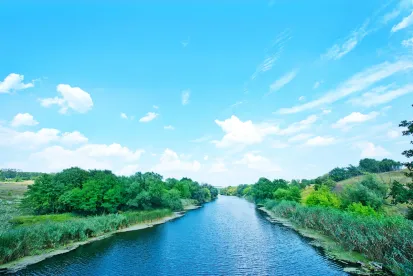On 30 December 2022, the Environmental Protection Agency (EPA) and the U.S. Army Corps of Engineers (the Corps) (together, the Agencies) released a final rule redefining the scope of waters protected under the Clean Water Act (the Final Rule).1 The Final Rule repeals the definition of “waters of the United States” (WOTUS) that the Trump administration adopted in 2020 (the “Navigable Waters Protection Rule”), largely reverting to the pre-2015 regulatory definition of WOTUS (albeit with some new clarifications and guidance).2 While this rulemaking seeks to strike a balance between historic interpretation and Supreme Court precedent, it will not be the final word on defining the scope of WOTUS, in part because of the likely legal challenges to the Final Rule. Notably, the Final Rule does not significantly alter the Agencies’ prevailing interpretations regarding the types of streams, wetlands, and other waters that are subject to federal regulation. Rather, the Final Rule is an effort to retain the Agencies’ historic interpretation of the geographic scope of WOTUS while accounting for recent Supreme Court interpretations, which effectively codifies and reinforces regulatory uncertainty.
Uncertainty lingers for multiple reasons, and companies that require permits from the Corps should be aware of the challenges ahead. First, the Final Rule will likely be challenged by a variety of stakeholders in federal district courts across the country—just as they did when the Agencies promulgated the Navigable Waters Protection Rule in 2020 and its Obama-era predecessor, the Clean Water Rule, in 2015. Second, the Agencies issued the Final Rule in advance of the Supreme Court’s decision in Sackett v. EPA, a pending case in which the Supreme Court may establish new parameters for Clean Water Act jurisdiction. Notably, the same day that EPA and the Corps released the Final Rule, the acting U.S. solicitor general sent a letter to the Supreme Court notifying the justices of the Final Rule and pointing them to portions of the rulemaking preamble that address questions that Justice Elena Kagan raised at oral argument.3 Third, while not mentioned in the rulemaking materials, it appears that the Biden Administration still has plans for a second WOTUS rulemaking that could potentially include more significant changes, as confirmed in EPA’s new regulatory agenda that was released on 4 January 2023.4
This newest development in the WOTUS saga again portends significant issues ahead, including protracted litigation and continued uncertainty for companies seeking to advance infrastructure projects that require a Corps permit.
CONTENTS OF THE FINAL RULE
The Final Rule tracks closely with the proposed rule, incorporating the pre-2015 regulatory regime that is based on the Agencies’ 1980’s-era WOTUS regulations with modifications to account for the Supreme Court’s decisions in Solid Waste Agency of Northern Cook County v. U.S. Army Corps of Engineers (SWANCC)5 and Rapanos v. United States.6
In the Final Rule, the Agencies construe the term “waters of the United States” to include:
-
Traditional navigable waters, the territorial seas, and interstate waters (“paragraph (a)(1) waters”);
-
Impoundments of other jurisdictional WOTUS;
-
Tributaries that meet either the “relatively permanent” standard or the “significant nexus” standard (“jurisdictional tributaries”);
-
Wetlands adjacent to paragraph (a)(1) waters; wetlands adjacent, and with a continuous surface connection, to relatively permanent tributaries and impoundments; and wetlands adjacent to other jurisdictional tributaries and impoundments when the wetlands meet the significant nexus standard; and
-
Intrastate lakes and ponds, streams, or wetlands not identified in paragraphs (a)(1) through (4) that meet either the relatively permanent standard or the significant nexus standard.
The Final Rule also codifies longstanding exclusions featured in earlier regulations and Agency guidance, including: waste treatment systems designed to meet the requirements of the Clean Water Act; prior converted cropland; ditches excavated wholly in and draining only dry land and that do not carry a relatively permanent flow of water; and swales and erosional features characterized by low volume, infrequent, or short duration flow.
“SIGNIFICANT NEXUS” AND “RELATIVELY PERMANENT” STANDARDS
The Final Rule includes language that expressly incorporates both the “relatively permanent” and “significant nexus” jurisdictional tests articulated in Rapanos. In Rapanos, a four-Justice plurality (led by former Justice Scalia) interpreted the term “waters of the United States” as encompassing “relatively permanent, standing or continuously flowing bodies of water,” that are connected to traditional navigable waters, as well as wetlands with a “continuous surface connection” to such water bodies.7 However, Justice Kennedy’s concurring opinion in Rapanos took a different—and, in practice, more expansive—approach, holding that “a water or wetland must possess a ‘significant nexus’ to” traditional navigable waters in order qualify as WOTUS.8 Neither the plurality nor Justice Kennedy’s formulation commanded a majority, and so the Agencies have typically exerted authority over waters that meet either test, as reflected in EPA guidance issued after the Rapanos decision.9 However, the 2020 Navigable Waters Protection Rule broke from that tradition by eliminating the significant nexus test as a ground for asserting jurisdiction. The Final Rule now reverts to the Agencies’ prior practice and codifies both tests.
The Final Rule does not include a regulatory definition explaining what is required for a tributary to be considered “relatively permanent.” However, the preamble to the Final Rule explains that the “relatively permanent standard encompasses surface waters that have flowing or standing water year-round or continuously during certain times of the year” but not those “with flowing or standing water for only a short duration in direct response to precipitation.”
To implement the significant nexus standard, the Final Rule provides for jurisdiction over any stream, wetland, lake or pond “[t]hat either alone or in combination with similarly situated waters in the region, significantly affect[s] the chemical, physical, or biological integrity of” paragraph (a)(1) waters (i.e., traditional navigable waters, the territorial seas, and interstate waters). The Final Rule includes a new definition of “significantly affect,” which means “a material influence on the chemical, physical, or biological integrity of waters identified” by this rule. Further, to determine what constitutes a “material influence,” the Final Rule identifies multiple functions and factors that the Agencies must consider, such as the distance from a WOTUS, hydrologic factors, landscape position and geomorphology, and climatological factors (among others).
ADJACENT WETLANDS
Of particular interest to the justices during the Sackett oral arguments was the extent to which wetlands “adjacent” to WOTUS also constitute WOTUS. The Final Rule includes as WOTUS wetlands adjacent to traditional navigable waters, the territorial seas, and interstate waters; wetlands adjacent, and with a continuous surface connection, to relatively permanent tributaries and impoundments; and wetlands adjacent to other jurisdictional tributaries and impoundments that meet the significant nexus standard. The Final Rule maintains the Agencies’ longstanding definition of “adjacent” as meaning “bordering, contiguous or neighboring,” even if there is separation by natural or artificial features. In the preamble to the Final Rule, the Agencies further explain that adjacency is established if a wetland’s proximity to a jurisdictional water is sufficiently close that “the wetland can modulate water quantity or water quality in the jurisdictional water, and the jurisdictional water can modulate water quantity or quality in the wetland.” The Agencies considered, but expressly rejected, adopting any more specific, bright-line distance limitation to determine adjacency.
The preamble to the Final Rule seeks to provide a defense of Clean Water Act jurisdiction over adjacent wetlands, perhaps speaking directly to some of the justices’ concerns. It is notable, however, that the Final Rule also (more quietly) allows for the assertion of jurisdiction over even non-adjacent wetlands that nevertheless meet the significant nexus standard. This creates regulatory uncertainty for landowners and project developers with seemingly isolated wetlands on their properties. Such landowners and project developers will not be able to definitively rule out Clean Water Act jurisdiction without undertaking a more intensive analysis of potential hydrological connections between the wetlands on their property and other similarly situated regional water bodies, which requires the assistance of outside consultants or seeking a Project-specific jurisdictional determination from the Corps.
WHAT COMES NEXT?
The Final Rule attempts to clarify the bounds of WOTUS by codifying the Agencies’ mostly familiar standards and practices. However, those standards and practices themselves have come under fire for years as not providing sufficient certainty to the regulated community. In particular, reliance on the Agencies’ “adjacency” and “significant nexus” tests can give rise to uncertainty with respect to the jurisdictional status of marginal wetlands, intermittent and ephemeral streams, ditches, and a variety of region-specific water features.
That said, the Final Rule is significantly different from both the Trump administration’s Navigable Waters Protection Rule and the Obama administration’s Clean Water Rule in its level of ambition. While the Navigable Waters Protection Rule sought to dramatically scale back the scope of waters subject to federal regulation, and the Clean Water Rule would have brought additional waters within the Agencies’ reach, the Final Rule more closely adheres to the Agencies’ long-standing rules and practices. Both prior rules encountered significant opposition in the courts and were subject to injunctions that increased uncertainty for the regulated community. Similar legal challenges are expected to the Final Rule.
Additionally, the Supreme Court’s impending decision in Sackett could significantly alter the playing field for litigation concerning the Final Rule. While the Agencies have done their best to ensure that the Final Rule is legally durable under the Supreme Court’s current precedent, the Sackett decision could abruptly change the legal foundation that underpins the Final Rule and give rise to new legal vulnerabilities.
Perhaps because of this, the EPA has included in its newest regulatory agenda, released 4 January 2023, plans to propose yet further refinements to the definition of WOTUS as early as November 2023. Through this second rulemaking, the Agencies have indicated that they “intend to consider further refinements [to the WOTUS rule] … in light of additional stakeholder engagement and implementation considerations, scientific developments, litigation and environmental justice values.”
The Final Rule will take effect 60 days after it is published in the Federal Register.
FOOTNOTES
1 https://www.epa.gov/system/files/documents/2022-12/Pre-Publication%20Final%20Rule%20Notice.pdf.
4 https://www.reginfo.gov/public/do/eAgendaViewRule?pubId=202210&RIN=2040-AG13
5 531 U.S. 159 (2001).
6 547 U.S. 715 (2006).
7 Id. at 739, 742.
8 Id. at 780.






 />i
/>i

